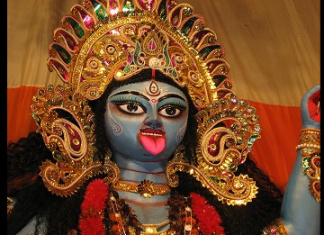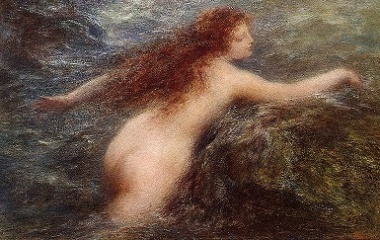Imagine coming across a bubbling spring in the wilderness of ancient Greece. If the merry tinkle of the water, the soft bed of moss on the spring’s bank, and the fragrant water flowers that dip over the water to gaze at their reflections are not enchanting enough for you, imagine a graceful woman with snow-white limbs and long, silky hair peeping out of the lilies. She is a Naiad, and her divine spirit has given this spring its spellbinding beauty.
What Are Naiads?
Naiads are demi-goddesses who dwell in the bright, fresh waters of ancient Greek civilizations. These enchanting ladies are deeply attached to their homes, and if a town happens to spring up near their waters, they will offer blessings and protection to the town—as long as its inhabitants don’t offend them.
Naiads are divided into many subcategories, depending on the type of water they call home. Pegaia inhabit springs and wells; krenaia make their home in fountains; potameides can be found in streams; limnades inhabit lakes; and heleionomai live in wetlands and marshes.
Characteristics
Physical Description
Naiads are ravishingly beautiful young women, with long graceful limbs and flowing hair. Their beauty is all the more devastating because they like to roam around without clothing, and many men—gods and mortals alike—have fallen under the enchantment of the “unshod” Naiad.
Special Abilities
Naiads exist on the cusp of immortality. So long as their home waters run strong, they remain young, beautiful, joyful, and vigorous. However, if their waters run low, their strength slips away from them.
Just as Naiads draw strength from their watery homes, the waters where a Naiad lives are said to absorb some of her magical qualities. Water from a Naiad’s home can heal the sick, inspire poets and prophets, and bring fertility to young women or crops. On a more basic level, the Naiad’s water is usually the best source of fresh water available to a town; it is the life-giving current around which civilization is built. Towns are frequently named in honor of the local Naiad, and shrines and offerings are made to keep her in good spirits, so that she will continue blessing her water.
If a Naiad is provoked, her anger is reflected in her waters. She can make water simmer with the heat of her fury, and she can unleash flash-floods or droughts upon her enemies. She can also change the quality of her water, making it yellow and wretched with sulfur, or white and sweet, like milk. Occasionally, she might undertake grander transfigurations such as hiding a lover by turning him into an echo or hiding herself by transforming into a stream.
Fortunately, Naiads are, for the most part, good and nurturing spirits, even if they do fall in and out of dramatic romances. Because of their gentleness and fondness for beauty and health, they often become nursemaids for the gods and children of the gods. Dionysos, Hera, Adonis, and Achilles were all attended by Naiads through the tender, early years of their lives.
Related Creatures
Naiads are just one of several races of Greek water spirits. Just as Naiads live and attend to fresh water, Oceanids inhabit salt water and Nereids live specifically in the Mediterranean. There are also river gods who govern Greece’s mightiest rivers. These gods are not Naiads, but they have fathered many of the beautiful Naiads who live in smaller streams and springs.
A Naiad answers to the other gods on Mount Olympus. When Zeus summons a Naiad to counsel, she abandons her beloved home and heads to Mount Olympus to hear his decrees. If a god happens to pass by a Naiad’s home and ask her for a favor, she will probably obey. The goddess Artemis, who shares the protective nature of the Naiad, particularly towards young girls, often works closely with the Naiads.
History
Origin
The Naiad is clearly a deep-rooted part of Greek culture. These alluring demi-goddesses seem to date back to the dawn of Greek civilization itself, which is not surprising, considering that they are strongly attached to the fresh water that made it possible for Greek towns to survive and prosper.
Naiads grace Greek pottery and mosaics that date back to the fourth century BC. They flit through some of Greece’s oldest hymns, tragedies, and epic poems, including Homer’s Odyssey and Iliad.
Roman Adaptation
It’s well known that Rome swallowed up many of ancient Greece’s mythological figures and stories. Most of them were altered and re-named to fit Rome’s political and religious agendas, but the Naiad remained untouched. Local people continued to worship their native Naiads, and Roman poets and philosophers continued to address the nymphs in their writings (most notably in Ovid’s Metamorphoses).
Famous Myths
Most of the myths that cling to Naiads are set into motion by the otherworldly beauty of these water spirits or by their passion for the beauty of others. Their romances have given birth to Greek heroes and nobility and to beautiful features of nature, like new streams or trees.
The gorgeous Naiad Cyrene was unusual among her sisters. She was not content to enjoy fragrant, waterside banquets and the silver Naiad music. Instead, she was like “a second Artemis,” with a huntress’s spirit. One day, she was walking near of flock of sheep when she saw them being attacked by a lion. She had no weapons with her, but her heart was fearless, and she began wrestling with the lion to save the sheep. The god Apollo discovered her in this courageous fight and was instantly taken with her beauty and valiance. Accordingly, he whisked the Naiad away to a city in North Africa, which he named after her, and together they had two sons, both demigods who went on to figure in other Greek myths.
The lovely Pholoe was less lucky in love than Cyrene. She was pursued by Pan, a hairy half-goat god who frequently made unwelcome advances towards beautiful women. Pholoe fled from Pan until, exhausted, she collapsed on the bank of her native lake. Pan was almost upon her when Artemis, who was hunting a deer nearby, spotted him hovering over the snow-white limbs of the fallen nymph. Angrily, Artemis threw a dart that pierced Pholoe’s hand and roused her to dive into the lake, where she wrapped herself in weeds to hide from Pan. Pan was bitterly disappointed and set an enchantment on a tree beside the lake, so that it would constantly drop leaves into Pholoe’s pristine pond.
The tale of Hylas sets the typical Naiad myth on its head; this time, the alluring water spirits are enamored by the beauty of a mortal man, the young Hylas who is travelling with Heracles on the Argonaut’s famous quest. Moved by the sight of the merry, curly-haired youth, the Naiads lure Hylas into their waters, where they want him to remain forever, sharing their beauty and happiness. When Heracles searches for Hylas, the nymphs turn Hylas into an echo, so that the only answer Heracles gets as he wanders the hills calling for his lost friend is Hylas’ name, ringing back to him.
Modern Literature
Although the term “naiad” has largely fallen out of use in modern literature, “water nymphs” still hold their grip on human imagination. They are found in many of the most beloved books of the fantasy genre, such as CS Lewis’s Chronicles of Narnia and JRR Tolkein’s Lord of the Rings trilogy.










